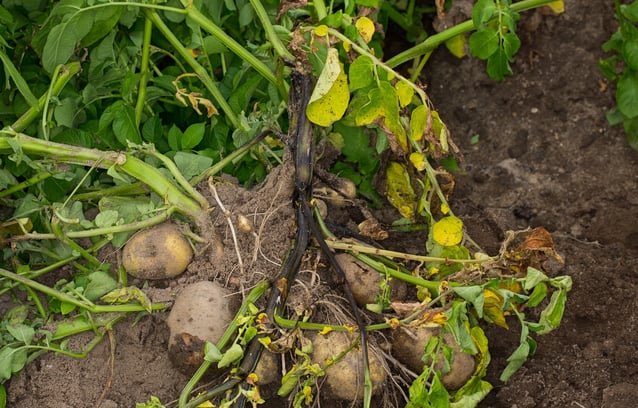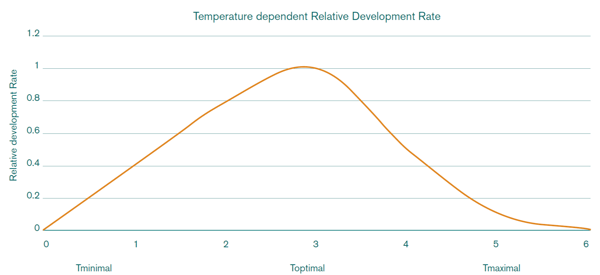
The development rate of pests and disease is the increase rate of their population. The population is expressed as the number of spores in case of fungi, as adults (imagoes) in the case of insects and as living larvae in case of nematodes.
The relative development rate (RDR) is the increase of the population (dP) per increase of the number of units of time (dt) of a population relative to its size (P). As a formula:

If for example there are 1,000,000 (one million) spores of Phytophthora in one cubic meter (1 m3) of air above the potato crop and every day 100,000 are added, the RDR is 100,000 : 1,000,000 = 0.1 per day.
Effect on pests and diseases
To study the effect of climate change on pests and diseases, the Relative Development Rate is defined and attributed to the climatic parameters temperature, evapotranspiration, relative humidity of the air or precipitation. The relative development rate is defined as the relative increase of the current pressure by the disease or pest. It has the value of 1 at its optimum and the value is zero at prohibitive high and low temperatures.
Daily relative development rate
Accumulation of the daily RDR (cRDR) before and after a climate change event is the result of the changed (usually increased) RDR per day and the changed number of days. In general, the number of growing days of crop and pests/ diseases is increased in summer crops and decreased in winter crops. The change in value of the cRDR indicates if a pest or disease becomes a greater or smaller problem with climate change. The approach also permits the comparison of different regions vis-à-vis expected disease and pests severity. This methodology and compilation of data was described by dr. Jacquie van der Waals and colleagues. Some of the changes in past and future changes in populations of pests and diseases are due to globalization with people and goods moving around at greater speed and intensity than before. They bring pests and diseases where they were not present before. Current human activity is a combination of introducing favorable conditions for novel pests and diseases as well as shifting them.

The Relative Development Rate of many pests and diseases is temperature-dependent. The optimum is 25°C for bacterial soft rots, 30°C for brown rot, 21°C, 24°C and 26°C for white, golden and root knot nematodes respectively.
Want to keep reading about the effects of climate change on the potato crop and potato cultivation?
Our Potato handbook is a global potato university in 1 book!
Buy your copy today and get a one-year free subscription to PotatoWorld magazine.

